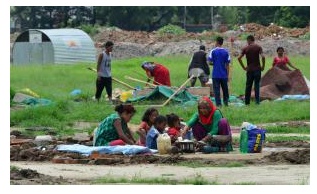
As dark clouds loomed overhead, Rabi Baral hurriedly secured his tent to the ground at a camp for victims of Nepal’s earthquake, three months after the disaster upended his life.
The 7.8-magnitude quake on April 25 destroyed the 41-year-old’s home and left him without a job, forcing him and his young family to take refuge in a makeshift camp in Nepal’s capital Kathmandu.
“The rain has made life even more difficult, but we have no choice right now,” Baral told AFP.
As his wife Parwati nursed their 18-month-old son, Baral said he was desperate to return home to the hills east of Kathmandu but was too afraid to risk travelling on quake-hit roads that now face the threat of landslides triggered by heavy rains.
“We are in limbo right now. I am counting days for monsoon to end so we can plan ahead,” he said.
Three months on, Nepal is still reeling from the impact of the earthquake that killed over 8,800 people and flattened nearly 600,000 homes, leaving thousands in desperate need of food, clean water and shelter.
According to the World Health Organization (WHO), landslides are already hampering delivery of relief supplies to mountainous villages and there are concerns that the monsoon could trigger an outbreak of diarrhoea and other water-borne diseases.
Edwin Salvador, Emergency and Humanitarian Technical Officer at WHO Nepal, told AFP that the agency had already delivered three months’ worth of medicines to remote villages at risk of landslides to ensure adequate supplies in the event of an emergency.
“After the earthquake hit, we were thinking forward to prepare for the monsoon,” Salvador said.
“There hasn’t been a health crisis so far, but preparedness is key. We are working closely with the community to prevent any such outbreak,” he added.
Devastated economy
Nepal’s economy—one of the world’s weakest even before the disaster—was hit hard by the quake, with the country’s annual GDP forecast to grow just three percent, the lowest in eight years.
Growth prospects have plummeted in crucial sectors like agriculture and tourism, with the disaster destroying crops and triggering deadly avalanches at Mount Everest base camp and on the popular Langtang trekking route, which remains closed to visitors.
In a bid to lure foreign visitors back, Nepal recently called in international experts to assess the safety of the popular Everest and Annapurna trekking routes.
Engineers from Miyamoto, a US-based firm, found that the Annapurna route was largely unaffected, with only six of 250 guesthouses assessed showing repairable damage. They plan to release their findings on quake-hit Everest next month.
“Our priority right now is to send out a positive message that Nepal is safe for travel,” said Tulsi Gautam, chief of Nepal’s tourism department.
“If we use this time to reassure our visitors, I am sure that tourism will bounce back in our next peak season which begins October,” Gautam added.
According to the government’s estimates, the Himalayan nation will need around $6.7 billion to fund rebuilding, with donors already offering pledges worth $4.4 billion for reconstruction.
The government wants reconstruction funds to be channelled through a new state body, raising concerns that bureaucracy and poor planning will delay rebuilding.
One month after the government pledged to lay out a clear roadmap to recovery at a donors’ meet, Kathmandu is yet to set up the new body, while homeless victims have received just $150 out of a promised $2,000 to rebuild their houses.
“The new fiscal year has just begun. We are in the process of establishing the reconstruction authority,” said Finance Minister Ram Sharan Mahat.
“We are at the beginning of the reconstruction phase. Our ministries are preparing rebuilding plans”, Mahat told AFP.
The remittance sector was one of the rare areas that saw growth even after the quake, with money transfers increasing by 11.2 percent to $5.55 billion in the first 11 months of this fiscal year, according to Nepal’s central bank.
Every year, thousands of young people leave Kathmandu in search of jobs in India, South East Asia and the Gulf nations, keeping the economy afloat with the earnings they send home.
After the disaster, many Nepalis are looking overseas to secure the funds they need to rebuild their lives, with quake survivor Baral saying that he hopes to go to India to find work.
“Where else will the money come from? I have a family to take care of, I have to rebuild,” he said.



